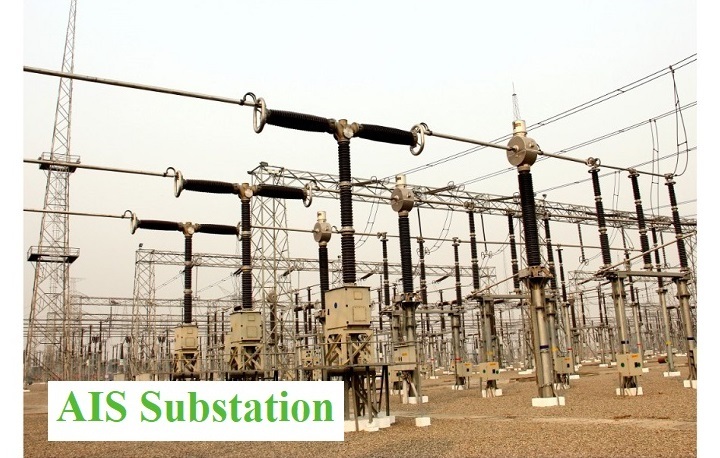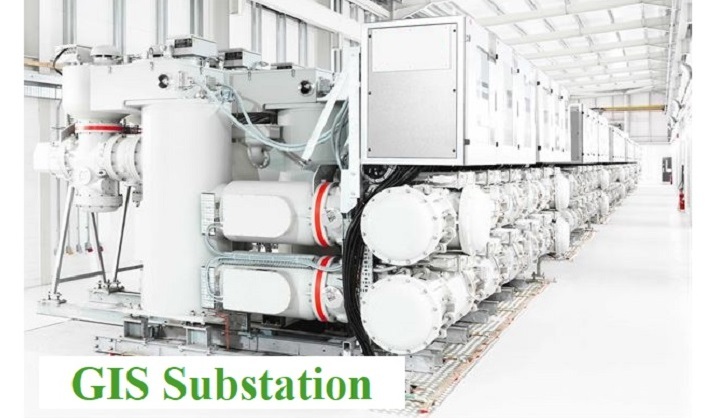
 Data Structure
Data Structure Networking
Networking RDBMS
RDBMS Operating System
Operating System Java
Java MS Excel
MS Excel iOS
iOS HTML
HTML CSS
CSS Android
Android Python
Python C Programming
C Programming C++
C++ C#
C# MongoDB
MongoDB MySQL
MySQL Javascript
Javascript PHP
PHPPhysics
Chemistry
Biology
Mathematics
English
Economics
Psychology
Social Studies
Fashion Studies
Legal Studies
- Selected Reading
- UPSC IAS Exams Notes
- Developer's Best Practices
- Questions and Answers
- Effective Resume Writing
- HR Interview Questions
- Computer Glossary
- Who is Who
Difference between AIS and GIS Substation
AIS and GIS are the two most widely used switchgear technology in the field of electrical substations. AIS stands for Air Insulated Switchgear and GIS stands for Gas Insulated Switchgear.
A substation in which the insulation between phases is provided by the atmospheric air is called an air insulated substation or AIS substation. On the other hand, a substation in which the insulation within phase and between phases is provided by SF6 gas is known as a gas insulated substation or GIS substation.
The primary difference between AIS substation and GIS substation is that an AIS substation uses the atmospheric air for insulation between live components, while the GIS substation uses the SF6 gas as the insulation medium between live components.
In this article, we will explain the basics of AIS and GIS substations along with their major differences.
What is an AIS Substation?
As mentioned above, AIS stands for Air Insulated Switchgear.A substation in which air insulated switchgear used is referred to as an AIS substation.It is sometimes directly referred to as air insulated substation.
However, it is important to note that AIS is not a substation, but it is a switchgear technology used in substations. Therefore, we can refer a substation as an AIS substation, if it is based on AIS technology.
A typical air insulated substation is shown in the following figure.

It can be seen that the electrical equipment used in the AIS substation are openly installed in atmospheric air. The atmospheric air provides both insulation and cooling to the live components/equipment.
Since we know that atmospheric air has lower insulation property or dielectric strength. Therefore, a large spacing or clearance between live parts is required in an AIS substation to avoid any electrical issues.
Advantages of AIS Substations
The following are some key advantages of AIS substations -
- AIS substations require a lower construction and installation cost.
- AIS substation equipment are less expensive.
- A less time is required for installation of AIS substations.
- AIS substations have an open design that makes its inspection and maintenance easier.
- AIS substations can be expended as needed due to open and flexible design and layout.
- It does not require any special cooling arrangement, as the air circulating around the equipment can provide cooling as well.
Disadvantages of AIS Substations
The main disadvantages of AIS substations are listed below -
- AIS substations require a large space or clearance between live components. Thus, a large land area is needed to install these substations.
- AIS substations are not much reliable.
- AIS substations have open design. Hence, their operation is affected by several environmental factors like rain, moisture, pollution, corrosion, etc.
- AIS substations require relatively higher operation cost due to need for more maintenance.
From this discussion, we can conclude that an AIS substation is a low cost and simple to design substation type used in areas where large land area is easily available and an extra high voltage level in transmission and distribution is required.
What is a GIS Substation?
As previously stated, GIS stands for Gas Insulated Switchgear. A substation in which gas insulated switchgear technology used is known as a GIS substation or simply gas insulated substation.
In a GIS substation, all the live components like circuit breakers, isolators, busbars, CT, PT, etc. are enclosed within a chamber filled with SF6 gas and tightly sealed. The SF6 is used to provided required insulation between the components.
Here is an image of a typical GIS substation -

Since SF6 gas has excellent insulation properties, GIS substations have a compact design and require less land space for installation.
Due to sealed design, the GIS substations reduce the risk of accidental contact with live components and hence, they are safer.
Advantages of GIS Substations
The following are some main advantages of the GIS substations -
- GIS substations have an excellent insulation medium that is SF6 gas. It provides better dielectric strength.
- GIS substations have a sealed design layout that reduces the chances of electrical accidents and improve safety.
- SF6 gas is used in GIS substations which has excellent insulation properties. This helps in reducing the clearance between live components and make these substations compact.
- GIS substations have a modular design. Thus, they can be easily upgraded as per requirements.
- A very less maintenance is required in GIS substations.
- GIS substations have high reliability.
Disadvantages of GIS Substations
The following are some major disadvantages of the GIS substations -
- GIS substations require higher capital cost and installation cost.
- GIS substations require highly skilled operation and maintenance personnel. This further increases their operational cost.
- If any internal fault occurs in the GIS substation, it can be very costly and sever.
So, this is all about GIS substations. These substations are becoming popular in modern days due to their higher efficiency, compact design, and reliability.
Till this section of the article, we have discussed about basics of AIS and GIS substations. Let us now understand the differences between AIS and GIS substations through their comparative study.
Difference between AIS and GIS Substations
The following table highlights all the significant differences between AIS and GIS substations -
| Parameter | AIS Substation | GIS Substation |
|---|---|---|
| Full form | AIS stands for Air Insulated Switchgear. | GIS stands for Gas Insulated Switchgear. |
| Insulating medium within phase | In AIS substations, Air/Oil/SF6 gas can be used as the insulating within phase. | In GIS substations, SF6 gas is used as the insulating medium within phase. |
| Insulating medium between phases | In AIS substations, air is used as the insulating medium between phases. | In GIS substations, SF6 gas is used as the insulating medium between phases. |
| Initial cost | AIS substations have a lower initial cost. | The initial cost of GIS substations is relatively high. |
| Operation and maintenance cost | AIS substations have high operation and maintenance cost. | The operation and maintenance cost of GIS substations is low. |
| Land area | AIS substations require large land area for installation. | GIS substations require smaller land area for installation. |
| Maintenance periodicity | AIS substations require frequency maintenance. | The maintenance periodicity for GIS substations is low. |
| Losses | AIS substations have high losses. | Losses in GIS substations are low. |
| Reliability | AIS substations are less reliable. | GIS substations have high reliability. |
| Flexibility | AIS substations are highly flexible in terms of extension. | GIS substations have limited extension flexibility. |
| Civil construction cost | AIS substations have lower civil construction cost. | GIS substations require high cost involved in civil work. |
| Maintenance hours/year | AIS substations have more maintenance hours per year. | GIS substations have lower maintenance hours per year. |
| Erection and commissioning time | AIS substations require more time in erection and commissioning. | Erection and commissioning time for GIS substations is very low. |
| Size | AIS substations have large sized design. | GIS substations have compact design. |
| Equipment placement | In AIS substations, the equipment like circuit breakers, isolators, CT, PT, etc. are installed in open air. | In GIS substations, these equipments are enclosed within a sealed chamber filled with SF6 gas. |
Conclusion
From the above discussion, we can conclude that both types of substations have their own advantages and disadvantages. AIS substations are those that use atmospheric air as the main insulating medium and have an open design. In contrast, GIS substations use SF6 gas as the primary insulating medium and have a closed design.
FAQs Related to AIS and GIS Substations
Some of the commonly asked questions related to AIS and GIS substations are answered below -
1. What are the advantages of AIS over GIS?
The following are some key advantages of AIS substations over GIS substations -
- The initial cost required for installation of AIS substations is lower than that of GIS substations.
- AIS substations have open design that makes inspection and maintenance work easier than GIS substations.
- AIS substations are easy to expend due to open design and layout.
- The operation cost involved in AIS substations is lower, as they require less skills operating personnel than GIS substations.
2. Why GIS is better than AIS?
The following reasons make the GIS substations better than AIS substations -
- GIS substations have compact design. Hence, they require smaller land area.
- GIS substations have sealed and enclosed design that reduces the risk of accidental contact with live parts.
- GIS substations require very low maintenance.
- GIS substations provide stable and reliable operation than AIS substations.
3. What is the difference between air insulated and gas insulated switchgear?
Air insulated substations use atmospheric air as the main insulating medium, whereas gas insulated substations use SF6 gas as the main insulating medium.
4. What is the cost comparison between GIS and AIS?
The cost comparison between GIS and AIS substations is given in the following table -
| Cost | GIS Substation | AIS Substation |
|---|---|---|
| Land cost | For GIS substations, land cost is lower. | For AIS substations, the land cost is high. |
| Initial cost | GIS substations have high initial cost due to expensive equipment. | AIS substations have low initial cost. |
| Civil cost | AIS substation involves a low civil construction cost. | GIS substation requires a high civil work cost. |
| Maintenance cost | AIS substations have high maintenance cost. | GIS substations have low maintenance cost. |
| Operational cost | AIS substations involve low operational cost. | GIS substations have high operational cost. |
5. What is the main disadvantage of AIS?
The main disadvantage of AIS substations is that they require large land for installation.

